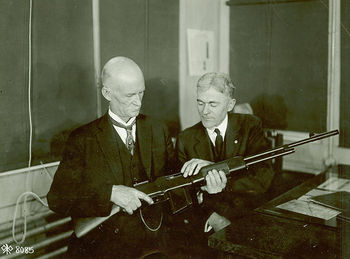Browning Automatic Rifle: Difference between revisions
imported>George Swan (first draft) |
imported>George Swan (more details) |
||
| Line 1: | Line 1: | ||
{{subpages}} | {{subpages}} | ||
{{Image|John M Browning and a Browning Automatic Rifle (BAR).jpg|right|350px|John M Browning and a Browning Automatic Rifle (BAR).}} | {{Image|John M Browning and a Browning Automatic Rifle (BAR).jpg|right|350px|John M Browning and a Browning Automatic Rifle (BAR).}} | ||
The '''Browning Automatic Rifle''' was large rifle developed by [[American gunsmith]] [[John M. Browning]], for use in [[World War One]].<ref name=TheBARHodges2012> | |||
{{cite book | |||
| url = http://books.google.ca/books?id=AF3HHRFY1_wC&printsec=frontcover&dq=%22Browning+Automatic+Rifle%22&source=bl&ots=Y6nbc1gQd5&sig=vMSIbHasvEpMxxoecEE1oasX39Q&hl=en&sa=X&ei=_aIiULKQK4K69QTqw4HgBA&ved=0CDQQ6AEwAA#v=onepage&q=%22Browning%20Automatic%20Rifle%22&f=false | |||
| title = The Browning Automatic Rifle | |||
| author = Robert Hodges | |||
| illustrator = Johnny Shumate | |||
| publisher = [[Osprey Publishing]] | |||
| year = 2012 | |||
| isbn =9781780964102 | |||
| page = | |||
| accessdate = 2012-08-08 | |||
| archivedate = | |||
| archiveurl = | |||
| dead = no | |||
| quote = <!-- The concept grew out of the necessity to combat the deadly effects of the machine gun on the battlefield, especially during the early days of World War I -- the first major machine-gun war -- when traditional infantry riflemen were decimated long before they could get close enough to silence an enemy machine gun. --> | |||
Automatic-rifle tactics were developed to allow the rifleman or grenadiers to advance under the protective fire laid down by the automatic rifleman until the teams could get close enough to eliminate | |||
a hostile machine gun. | |||
<!-- | |||
The machine guns of the day were quite deadly but they were also heavy and difficult to move quickly across the battlefield. Many were water-cooled, and their water jacket and water can added | |||
significant weight to the weapon. The tripod and ammunition boxes added even more weight, and hte guns sometimes required a cart to transport them. | |||
--> | |||
}} | |||
</ref> | |||
It was first introduced in 1917, and continued in use by US forces until after the [[Korean War]]. | |||
It was designed to help counter defensive machine gun nests during World War One's trench warfare stalemate.<ref name=TheBARHodges2012/> | |||
Unlike the heavier [[machine gun]]s it was designed to counter the BAR was man-portable. Gunners could provide automatic fire to cover riflemen advancing on an enemy machine gun emplacement. | |||
The BAR used 20 or 40 bullet magazines.<ref name=TheBARHodges2012/> | |||
In World War One the gunner would be assisted by a loader and an ammunition carrier. In World War Two the gunner would be assisted by only one other soldier. | |||
The cyclying of bullets through the weapon was powered by harnessing some of the expanding gas from firing the previous bullet.<ref name=TheBARHodges2012/> | |||
==References== | |||
<references/> | |||
Revision as of 15:08, 8 August 2012
The Browning Automatic Rifle was large rifle developed by American gunsmith John M. Browning, for use in World War One.[1] It was first introduced in 1917, and continued in use by US forces until after the Korean War.
It was designed to help counter defensive machine gun nests during World War One's trench warfare stalemate.[1] Unlike the heavier machine guns it was designed to counter the BAR was man-portable. Gunners could provide automatic fire to cover riflemen advancing on an enemy machine gun emplacement.
The BAR used 20 or 40 bullet magazines.[1] In World War One the gunner would be assisted by a loader and an ammunition carrier. In World War Two the gunner would be assisted by only one other soldier.
The cyclying of bullets through the weapon was powered by harnessing some of the expanding gas from firing the previous bullet.[1]
References
- ↑ 1.0 1.1 1.2 1.3 Robert Hodges (2012). The Browning Automatic Rifle. Osprey Publishing. ISBN 9781780964102. Retrieved on 2012-08-08. “Automatic-rifle tactics were developed to allow the rifleman or grenadiers to advance under the protective fire laid down by the automatic rifleman until the teams could get close enough to eliminate a hostile machine gun.”
